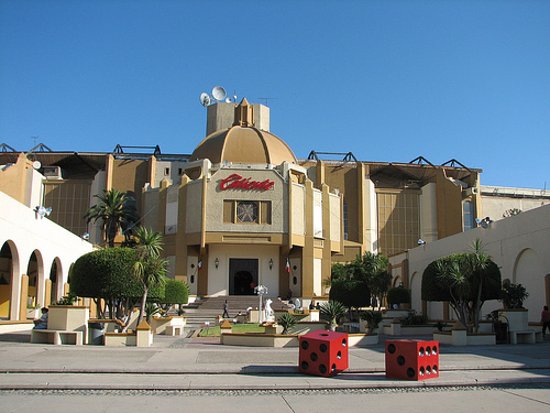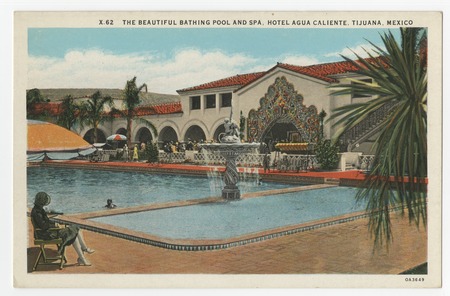Casino Agua Caliente Tijuana Mexico
The Agua Caliente Casino is a gambling facility, run by the Agua Caliente Band of Cahuilla Indians, in Rancho Mirage, California. The facility has over 45,000 square feet (4,200 m 2) of gambling floor. The casino completed a 16-story, 173-foot (53 m) hotel tower which opened on April 18, 2008. Agua Caliente opened in 1928, and a year later, writes the author, “Its casino was said to be grossing at least $2 million a month, ten times that in today’s dollars.” “For glamour. Make a Day Trip to Caliente Casino Tijuana. Agua Caliente 12027, Hipodromo Agua Caliente, 22024 Tijuana, B.C., Mexico Phone: (619)-941-3190 Main Locations.

Casino Agua Caliente Tijuana Mexico Hotels

The Agua Caliente Casino and Hotel opened in 22 June 1928 in the Mexican city of Tijuana, Baja California. It was a lavish resort that included a casino, spa, championship golf and tennis facilities, its own airstrip, and a lot of entertainment. Stylistically, the resort was an amalgam of Mexican colonial, California mission, and neo-Islamic designs that ranged from mosaic minarets, to cozy guest bungalows, to steaming Turkish baths. It was designed by 19-year-old architect Wayne McAllister and built by Baron H. Long, Wirt G. Bowman and James N. Crofton. Some sources note the fourth partner was Abelardo L. Rodríguez, Military Commander and Governor of Baja California, and future Mexican President. The $2.5 million Agua Caliente racetrack opened in December 1929.
Drinking, gambling, and horse racing were illegal in neighboring California, so many wealthy Americans and Hollywood celebrities flocked to Agua Caliente. Rita Hayworth was discovered there while performing in a show. The films In Caliente and The Champ were filmed on location there. The highlight of the opulent casino was the Gold Room, where patrons could only bet using gold chips, with a rumored $500 minimum wager. Bugsy Siegel cited Agua Caliente as his inspiration for building the resort on what became the Las Vegas Strip.
Mexican PresidentLázaro Cárdenas outlawed gambling in 1935 and closed the resort. It became a state-run school, Escuela Preparatoria Federal Lázaro Cárdenas and eventually fell into disrepair. Remnants of the original buildings remain next to the Plaza Minarete strip center at the end of Avenida Sanchez Taboada. Although the casino and hotel were closed, the racetrack continued to operate for many years. The original grandstand structure was destroyed by fire in 1971, but was rebuilt and continues to operate today as the Agua Caliente Racetrack and casino, a branch of the Casino Caliente chain.
See also[edit]
References[edit]
The Agua Caliente Story: Remembering Mexico's Legendary Racetrack, David Jimenez Beltran (Blood-Horse Publications: Lexington, Kentucky) 2004
The Leisure Architecture of Wayne McAllister, Chris Nichols (Gibbs Smith, Publisher: Layton, Utah) 2007 [1]

External links[edit]
Casino Agua Caliente Tijuana Mexico Map
A brief history of the 'Monte Carlo en Tijuana' (and its fate) which opened in 1928
An orquesta típica serenaded diners at Tijuana’s Agua Calinente Hotel and Casino in 1928. Photo: Guy Sensor Landscape Photo, courtesy of San Diego History Center Photo Archive.
The Tijuana Agua Caliente Hotel and Casino
by Will Chandler
Built by three American sports promoters at a cost of over $1.5 million, Tijuana’s legendary Agua Caliente Hotel and Casino opened to the public on June 23, 1928. The enterprise was a spectacular success, thanks in part to its brilliantly staged development. A year’s advance press notices for the hotel were stoked by Caliente’s Phase 1 construction of a greyhound racetrack. The track opened on July 1, 1927, with record-breaking purse payouts that drew the racing sports world to Tijuana.
Known as the “Border Barons,” Caliente’s developers were Wirt G. Bowman (1874-1949, cattle rancher, capitalist and politician), James N. Crofton (1895-1968, rancher and sportsman)—both from Nogales, Arizona—and Baron H. Long (1883-1962, sports promoter and U.S. Grant Hotel owner). Bowman’s long friendships with northern Mexico’s politicians enabled rapid progress in Tijuana. Caliente’s contractor was Fernando F. Rodríguez, brother of northern Baja’s military commander and governor, Abelardo L. Rodríguez (1889-1967).
Named for its medicinal hot springs, the Agua Caliente resort complex included a therapeutic pool and spa, but its chief attractions for wealthy Americans were its luxurious gambling casino, greyhound races and elegant full-service cocktail bars. None of these entertainments were legal in California, and the resort’s location, less than three miles from the international border, was made even more accessible by transborder train service from San Diego to Caliente, and by twice-daily 12-passenger Ford Trimotor airplane flights from
Los Angeles and San Diego to its own airfield.
The hotel’s 300 guest rooms, private bungalows, lush gardens and superb food service guaranteed its popularity as a Hollywood getaway. Guests at the opening’s formal dinner included Al Jolson, Dolores del Rio, Charlie Chaplin, Sid Grauman, Raoul Walsh, Renée Adorée, Mabel Normand, Lupe Vélez, Jack Dempsey and United Artists’ president Joseph Schenck, who became the resort’s majority stockholder in 1932.
Surprisingly, the famously beautiful hotel was designed by fledgling architect Wayne D. McAllister (1907-2000) and his wife Corinne Fuller McAllister (1905-2001), better known for their midcentury-modern projects. Reported monthly casino and track receipts of $500,000 paid for rapid expansions of the hotel, a grass golf course, and, in 1929, a new $2.5 million racetrack and grandstand.
Even after the 1929 stock market crash, Caliente seemed destined for long-term success. Its pinnacle of glamor came with the Warner Bros. musical In Caliente, released May 25, 1935, and starring Dolores Del Rio and Pat O’Brien. But on July 20, incoming Mexican president Lázaro Cárdenas permanently revoked all gambling casino licenses, and the resort, then valued at $8 million, was abruptly forced to close at the height of its fame. The Caliente track was allowed to reopen, but the hotel was converted to a military school. ϖ